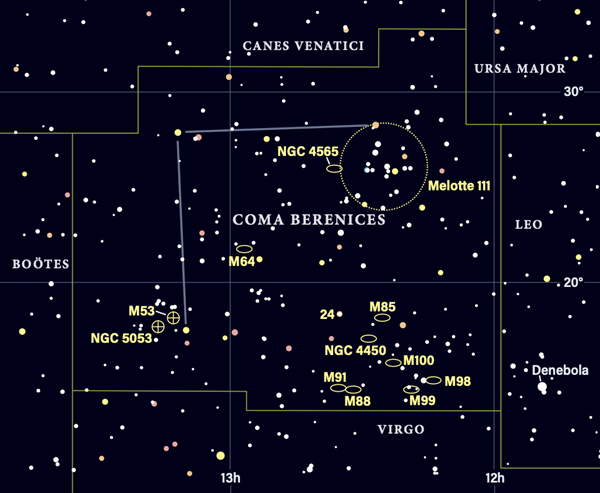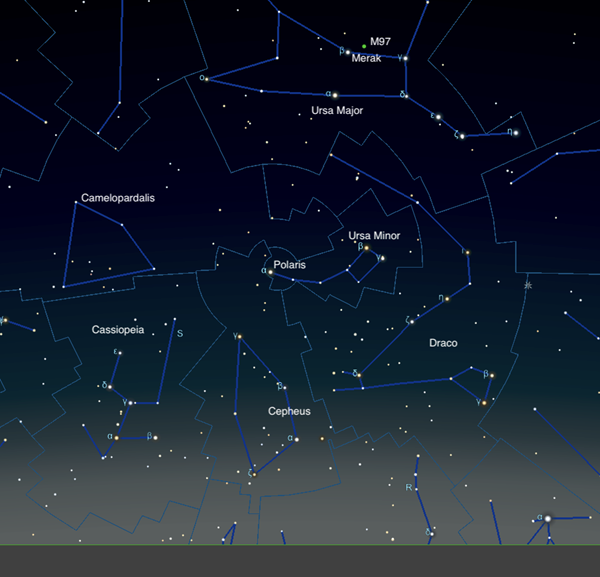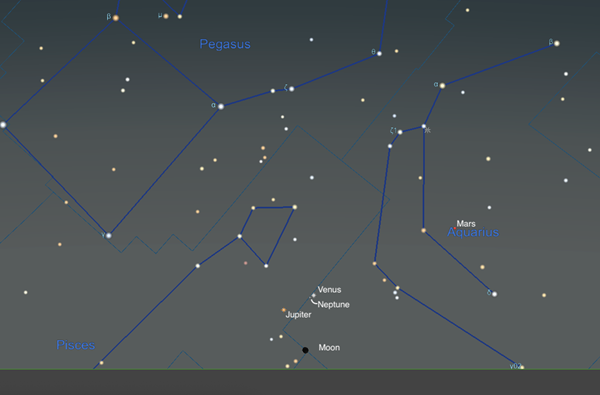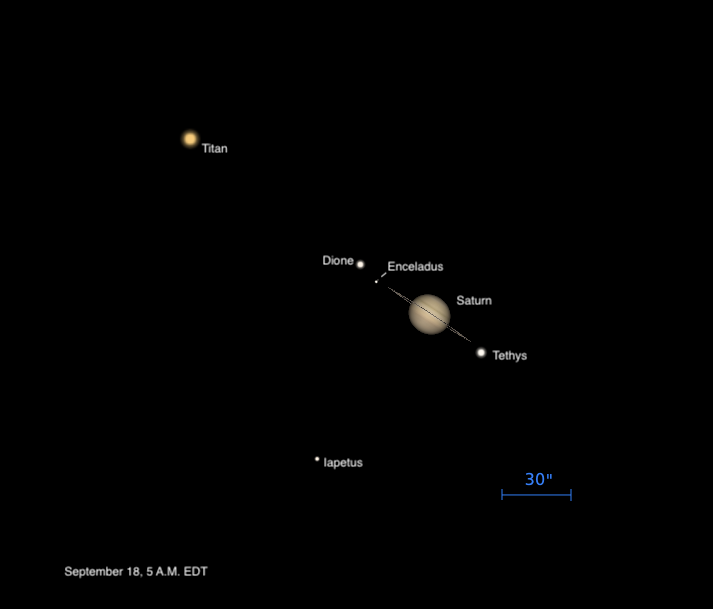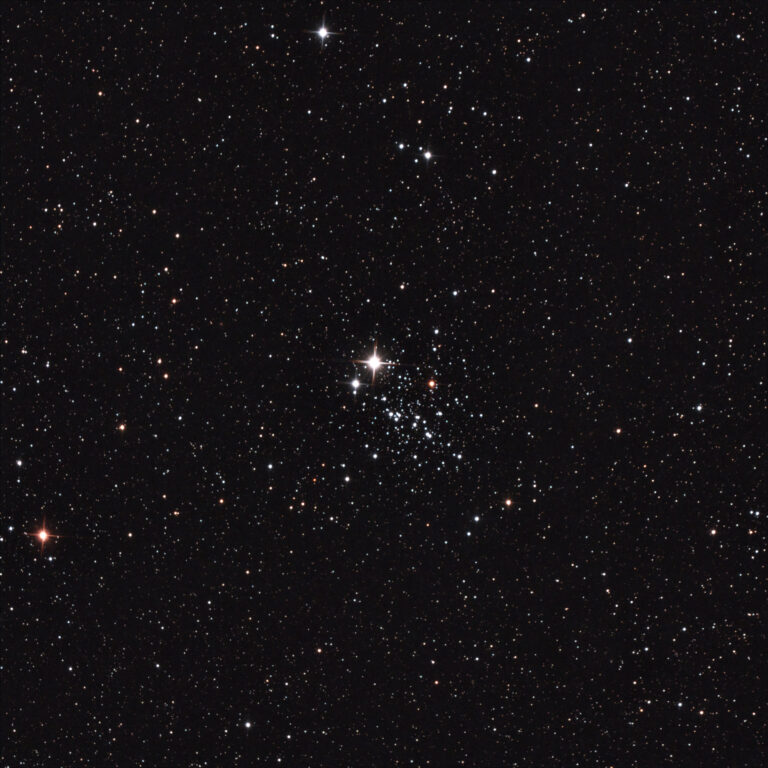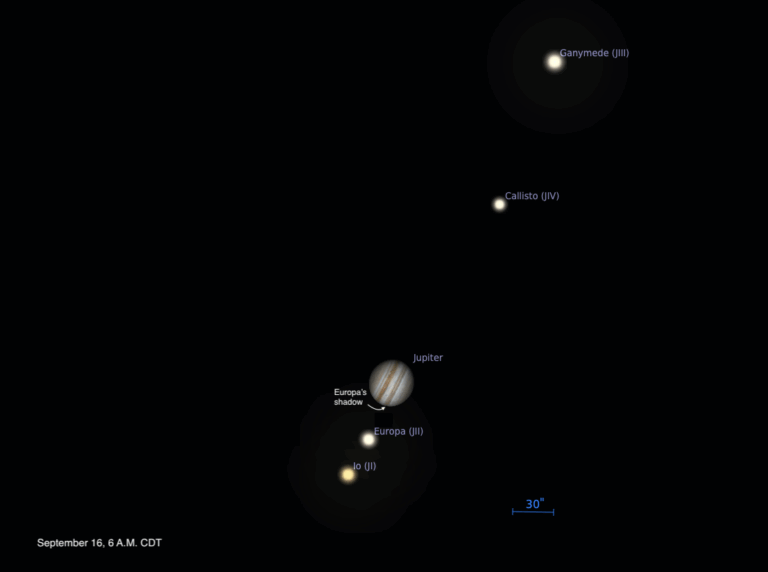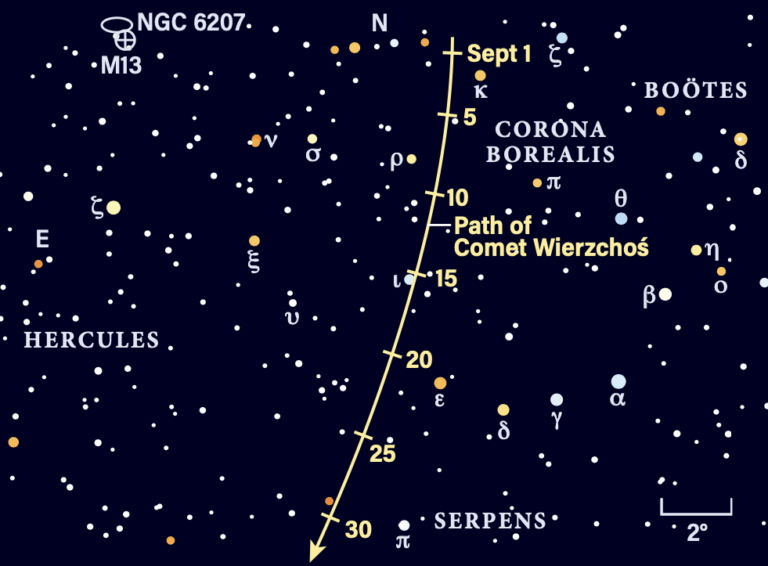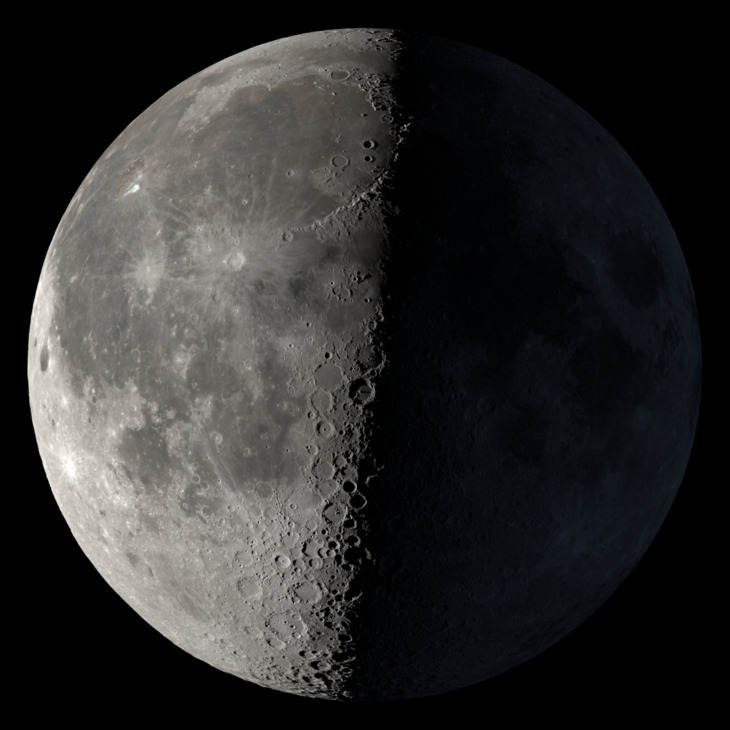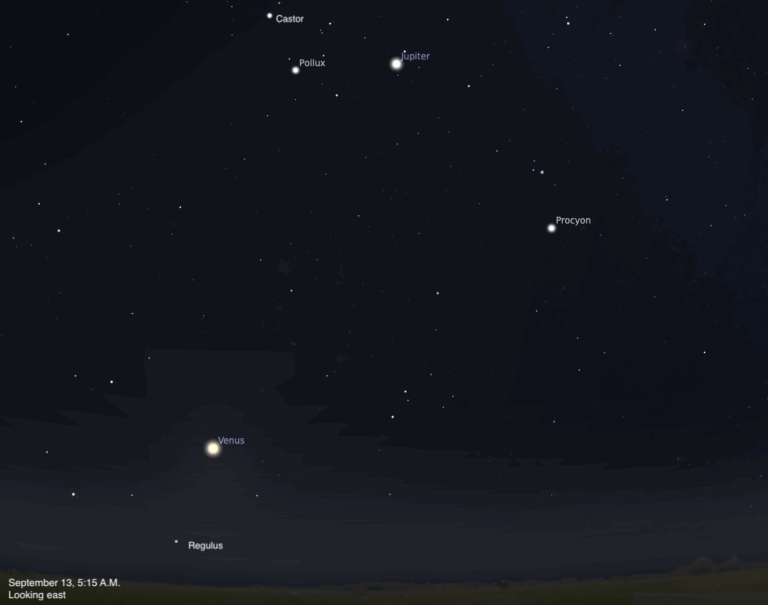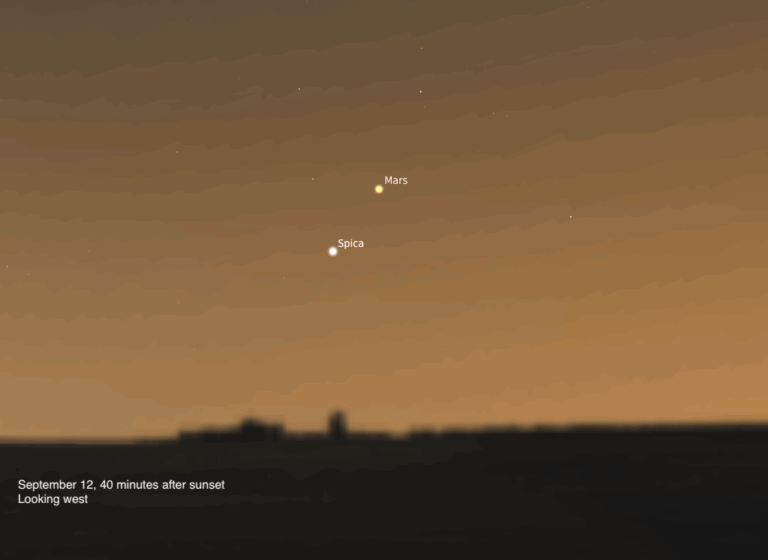Key Takeaways:
Friday, April 22
The annual Lyrid meteor shower peaks tonight. Its radiant, located near bright Vega in Lyra the Lyre, rises around 8 P.M. local time. For the best nighttime viewing of the shower, you’ll want to let that radiant get as high as possible, so wait until late this evening before stepping outside to watch for shooting stars.
Unfortunately, the radiant won’t get very high before midnight; if you’re willing to stay out into the early hours of tomorrow morning or alternatively get up a few hours before the Sun on the 23rd, your prospects will be a bit better. Early morning is always best to view meteor showers, as that’s when Earth’s rotation results in faster-moving shower meteors with longer trails. Lyrid meteors typically move through our atmosphere at speeds of about 30 miles (50 kilometers) per second — not particularly fast, as far as meteors go.
The Moon won’t interfere with your viewing late this evening, bumping up your chances of spotting more meteors. However, the Lyrids’ maximum rate at peak is only about 18 meteors per hour — and that number will be lower in reality, as the radiant will not sit directly overhead.
Sunrise: 6:12 A.M.
Sunset: 7:46 P.M.
Moonrise: 1:52 A.M.
Moonset: 10:55 A.M.
Moon Phase: Waning gibbous (59%)
*Times for sunrise, sunset, moonrise, and moonset are given in local time from 40° N 90° W. The Moon’s illumination is given at 12 P.M. local time from the same location.
Saturday, April 23
Last Quarter Moon occurs at 7:56 A.M. EDT. This lunar phase is characterized by early-morning rise times, meaning nighttime is now the perfect setting to view fainter, deep-sky objects.
Today, though, your evening target is a bright magnitude –0.4: the planet Mercury. This month brings us the tiny planet’s best evening apparition of 2022, and it will reach greatest elongation from the Sun in just a few days. But first, tonight offers a unique chance to step back through time and view mercury as Giovanni Schiaparelli saw it 140 years ago.
Schiaparelli began studying Mercury in 1882 and immediately saw what he believed was a giant figure 5 feature on the planet’s dark surface. Today, Mercury presents to us a nearly identical view to what Schiaparelli saw in early 1882.
Start by locating Mercury, which stands nearly 20° above the western horizon at sunset. It’s the first bright spot that will appear after sunset, making it easy to find. The planet sets around 9:30 P.M. local time and the best views will come earlier rather than later, as twilight is fading and Mercury is higher above the turbulent air at the horizon.
Zoom in on Mercury with any telescope and you’ll see the planet’s 6.8″-wide disk is 56 percent lit, as compared to the 7.0″-wide, 53-percent-lit planet Schiaparelli saw on Feb. 6, 1882. The longitude of Mercury’s central meridian tonight is 85°, compared with 86° in 1882. And if you have a larger telescope (6 to 10 inches), a look through the eyepiece will transport you squarely into Schiaparelli’s shoes, offering the same level of detail. Do you see the dark figure 5, or the bright spot of the crater Kuiper, which sits near the limb, just left of the 5?
Sunrise: 6:10 A.M.
Sunset: 7:47 P.M.
Moonrise: 2:43 A.M.
Moonset: 12:06 P.M.
Moon Phase: Waning crescent (48%)
Sunday, April 24
The Moon begins its parade past the planets lined up in the morning sky by sliding 5° south of Saturn at 5 P.M. EDT today. Before sunrise, you can spot our satellite sitting nearly even with Saturn above the southeastern horizon, still some 9° to the planet’s right (southwest). Both are in Capricornus the Sea Goat, with magnitude 0.7 Saturn located nearly directly above 3rd-magnitude Deneb Algedi.
Zoom in on Saturn with a telescope to spot the planet’s mighty ring system, currently tilted at nearly 13° to our line of sight. The planet’s disk stretches 16″ across and the rings slightly more than double that width. Saturn’s brightest moon, Titan, may also be visible through your scope, located about 43″ to the planet’s southwest this morning.
Stretching out along the ecliptic to Saturn’s left (east) are Mars (magnitude 0.9), Venus (magnitude –4.1), Neptune (magnitude 7.8, requiring binoculars to spot), and Jupiter (magnitude –2.1). The Moon will continue along this line throughout the week, passing south of each planet in turn. Plus, keep an eye on Venus — it too will move swiftly each morning, meeting up with first Neptune this week, then Jupiter next week. More on those exciting conjunctions to come.
Sunrise: 6:09 A.M.
Sunset: 7:48 P.M.
Moonrise: 3:25 A.M.
Moonset: 1:19 P.M.
Moon Phase: Waning crescent (37%)
Monday, April 25
The Moon passes 4° south of Mars at 6 P.M. EDT today. Earlier in the morning when both are visible before sunrise, its crescent floats in Aquarius, sitting south of a line connecting Mars and Saturn. Mars and Saturn lie about 8.5° to the Moon’s northeast and northwest, respectively.
If evening observing is more your speed, April nights are a great time to check out Coma Berenices, already some 40° high in the east at sunset and still rising. This lesser-known star pattern houses eight Messier objects and numerous other treasures, including the colorful double star 24 Comae Berenices, which sits in the relatively sparse southern region of the constellation. Its two components are 20″ apart and shine at magnitude 5.2 and 67 — easy to spot with any small scope. Their reported colors range from white to yellow and blue or even orange and green, depending on the observers’ eyes.
If you’re after telescopic targets with a little more wow factor, you’re in luck: M100 is a stunning grand design spiral galaxy in southwestern Coma Berenices. It shines at magnitude 9.4 and is one of the brightest members of the nearby the Coma-Virgo cluster of galaxies. M100 stretches about 7′ by 6′ across and is nearly face-on, showing off its winding arms and bright central bulge in larger (8-inch-plus) scopes. You’ll find this lovely target a little less than 2° east-northeast of 5th-magnitue 6 Comae Berenices.
Sunrise: 6:08 A.M.
Sunset: 7:49 P.M.
Moonrise: 3:58 A.M.
Moonset: 2:30 P.M.
Moon Phase: Waning crescent (26%)
Tuesday, April 26
The Moon continues past the planetary lineup by slipping 4° south of Venus at 10 P.M. EDT and then 4° south of Neptune an hour later. We’ll focus on this area, currently out of sight, tomorrow morning. As you may have guessed by the quick succession of those events, Venus and Neptune are quite close and will stand less than 30″ apart on the 27th, rendering both visible in the same telescopic field of view.
Tonight, Ursa Major the Great Bear lies on her back above the North Celestial Pole after sunset. Her legs sprawl in the air and the long, bent line of her elongated tail, also envisioned as the Big Dipper’s handle, stretches to the right (east). And just south of (currently above) the bottom of the Dipper’s bowl is planetary nebula M97, popularly known as the Owl Nebula.
To find it, locate Merak, Ursa Major’s 2nd-magnitude beta star. When the Big Dipper is right-side up, Merak marks the bowl’s lower righthand corner. Tonight, it is at the upper lefthand corner of the upside-down bowl in the sky. M97 sits 2.2° southeast of Merak, appearing directly to its right in the sky an hour after sunset tonight.
Glowing softly at magnitude 10 and spanning about 3″, the M97 is a complex nebula with two dark spots amid its circular glow, which lend the object the appearance of an owl’s face with two large, dark eyes — hence, the Owl Nebula. It will likely appear as a faint greenish smudge with even illumination through a smaller scope, but larger apertures (more than 4 inches) will begin to show the owl’s eyes.
Sunrise: 6:06: A.M.
Sunset: 7:50 P.M.
Moonrise: 4:26 A.M.
Moonset: 3:39 P.M.
Moon Phase: Waning crescent (18%)
Wednesday, April 27
The Moon passes 4° south of Jupiter at 4 A.M. EDT. Catch them an hour before sunrise, when bright magnitude –2.1 Jupiter is 5° high and the delicate waning crescent Moon is just 2° above the horizon, now sitting to the giant planet’s southeast.
But the real show is just west of Jupiter, where magnitude –4.1 Venus can’t be missed. Even though Earth’s sister planet is a bright morning star, pull out your binoculars or telescope because distant Neptune, glowing a faint magnitude 7.8, sits just 25′ to Venus’ east. That means you can spot both planets, near and far, in a single binocular or even telescopic field of view.
Compare and contrast the two — they couldn’t look more different. Blazingly yellow-white Venus’ disk is 17″ across and 66 percent lit. Meanwhile, Neptune appears as a full but tiny, “flat” blue-gray disk just 2″ wide. In reality, Neptune is 4 times wider than Venus — and nearly 42 times farther from the Sun!
You can follow the pair into bright twilight as Neptune eventually drops out of view. Make sure to put away your binoculars or telescope at least several minutes before the Sun is set to rise from your location (which may be a different time than the one listed below).
Venus will pass 0.007° (25′) directly south of Neptune later today at 3 P.M. EDT.
Sunrise: 6:05 A.M.
Sunset: 7:51 P.M.
Moonrise: 4:51 A.M.
Moonset: 4:45 P.M.
Moon Phase: Waning crescent (10%)
Thursday, April 28
Asteroid 10 Hygiea reaches opposition at 11 P.M. EDT, meaning it’s up all night, ready to observe. Plus, with no Moon in the nighttime sky, your prospects are good for catching this 10th-magnitude main-belt world, currently sitting near the southeastern corner of Virgo.
Wait at least two hours after sunset, then start your search by finding an easy target: 1st-magnitude Spica, Virgo’s well-known alpha star. You’ll see it shining brightly above the southeastern horizon. Hygiea lies 15° southeast of this star; you can alternatively find Hygiea by dropping about 9.2° south-southeast of 4th-magnitude Kappa (κ) Virginis. You’ll likely want a small (3- to 4-inch scope) to easily spot it, though observers with binoculars 50mm or larger should find it within reach as well.
Hygiea takes just over five and a half years to orbit the Sun and is the fourth-largest body in the main belt, coming in after (in order) 1 Ceres, 4 Vesta, and 2 Pallas. Some studies even estimate this nearly spherical world contains up to 3 percent of the entire mass in the main belt.
Sunrise: 6:04 A.M.
Sunset: 7:52 P.M.
Moonrise: 5:15 A.M.
Moonset: 5:50 P.M.
Moon Phase: Waning crescent (5%)
Friday, April 29
Mercury reaches greatest eastern elongation (21°) from the Sun at 4 A.M. EDT. At sunset, the planet is still 20° high in the west and won’t set for nearly two hours. Through a telescope (make sure the Sun has fully set before pulling it out!), Mercury now spans 8″ and appears 36 percent lit, a considerably different view than earlier in the week.
Give the scene an hour, though, and you’re in for a real treat because Mercury tonight sits close to two excellent bonus targets.
The first is the most obvious: Mercury is less than 1.5° from the stunning Pleiades (M45). Shortly before 9 P.M. local time, the sky should be dark enough to make out this young cluster’s stars, glittering just north of Mercury’s magnitude 0.2 light. Both are easily visible with the naked eye, but binoculars or a wide-field scope (or even your telescope’s finder scope) will also capture the view.
The second target is trickier and you’ll need to be fast: Still-brightening Comet C/2021 O3 (PanSTARRS) has also been increasing its elongation from the Sun since last week. It now sits nearly 4.5° west-southwest of Mercury, roughly 4° high an hour after sunset. (The comet is nearly 10° high half an hour earlier, if you want to try your luck then.)
PanSTARRS was last observed around magnitude 11; it has been slowly brightening and becoming easier to see as it hangs in the darkening sky longer after the Sun disappears. In addition to using Mercury as a signpost, try dropping straight down about 5° from the Pleiades toward the horizon to see if you can find PanSTARRS’ soft glow. 80mm binoculars or a small scope should net it, but it may take a bit of searching. The clearer your western horizon and the higher in altitude your observing site, the better.
Sunrise: 6:02 A.M.
Sunset: 7:53 P.M.
Moonrise: 5:38 A.M.
Moonset: 6:53 P.M.
Moon Phase: Waning crescent (1%)



